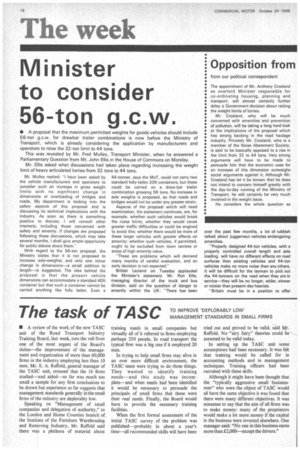Minister to consider 56-ton gx.w.
Page 20

Page 21

If you've noticed an error in this article please click here to report it so we can fix it.
• A proposal that the maximum permitted weights for goods vehicles should include 56-ton g.c.w. for drawbar trailer combinations is now before the Ministry of Transport, which is already considering the application by manufacturers and operators to raise the 32-ton limit to 44 tons.
This was revealed by Mr. Fred MuIley, Transport Minister, when he answered a Parliamentary Question from Mr. John Ellis in the [-louse of Commons on Monday.
Mr. Ellis asked what discussions had taken place regarding increasing the weight limit of heavy articulated lorries from 32 tons to 44 tons.
Mr. Mulley replied: -I have been asked by the vehicle manufacturers and operators to consider such an increase in gross weight limits with no significant change in dimensions or overloading of bridges and roads. My department is looking into the safety aspects of this proposal and is discussing its technical implications with the industry. As soon as there is something positive to discuss, I will consult other interests, including those concerned with safety and amenity. If changes are proposed following these discussions, which may take several months, I shall give ample opportunity for public debate about them."
With regard to the 56-ton proposal, the Ministry states that it is not proposed to increase axle-weights; and only one minor change in dimensions—a small addition to length—is suggested. The idea behind the proposal is that the present vehicle dimensions can accommodate a standard 40ft container but that such a container cannot be carried anything like fully laden. Even a 44-tonner, says the MoT, could not carry two standard fully-laden 20ft containers, but these could be carried on a draw-bar trailer combination grossing 56 tons. No increase in axle weights is proposed, so that roads and bridges would not be under any greater strain.
Aspects of the proposal which will need examination, the statement continues, are, for example, whether such vehicles would break the noise limits: whether they would cause greater traffic difficulties or could be engined to avoid this; whether there would be more of these larger vehicles with greater effects on amenity: whether such vehicles, if permitted, ought to be excluded from town centres or areas of high amenity value.
"These are problems which will demand many months of careful evaluation, and an early decision is not expected."
British Leyland on Tuesday applauded the Minister's statement. Mr. Ron Ellis. managing director of the truck and bus division, said on the question of danger to amenity within the UK: "There has been
over the past few months, a lot of rubbish talked about juggernaut vehicles endangering amenities.
"Properly designed 44-ton vehicles, with a properly controlled overall length and axle loading, will have no different effects on road surfaces than existing vehicles and 44-ton vehicles make no more noise than any others. It will be difficult for the layman to pick out the 44-tonners on the road when they are in service—they will be no longer, wider, slower or noisier than present-day heavies.
"Britain must be in a position to offer
transport users the most economical form of haulage vehicles if we are to compete effectively with our rivals. That is just what we are going to do". said Mr. Ellis.
Commentators in the industry have suggested that while the 56-ton trailer proposal is being discussed the regulations requiring a "second man" for such vehicles might also be looked at for revision. Doubts are expressed as to whether the saving resulting from carrying two 20ft containers on one drawbar trailer would be justified against the cost of two-men crews.




















































































































